MXA RACE TEST: THE REAL TEST OF THE 2022 YAMAHA YZ85/ YZ85 LARGE WHEEL

Q: IS THE 2022 YAMAHA YZ85 BETTER THAN THE 2021 YZ85?
A: Yes‚ and as icing on the cake, Yamaha added a big-wheel option of the YZ85, too. The 2022 season was big for Yamaha, as its YZ125 received an all-new engine, and both the 125 and 250 two-strokes received new bodywork, fuel tanks, brakes and seats to create a more modern look and riding position. Almost all the YZ85 updates were inspired by Yamaha’s bigger two-strokes. Additionally, minicycle updates are few and far between, so the 2023 YZ85 and YZ85LW will be the same machines as the 2022 models
Q: WHEN DID YAMAHA LAST UPDATE THE YZ85?
A: Surprisingly, the most recent changes on the YZ85 came only three years ago for the 2019 season. Then, the YZ85 saw updates to the engine, chassis, brakes and suspension. The engine gained the popular YPVS (Yamaha Power Valve System), which increased power from 3000 to 9000 rpm. According to Yamaha, the power valve increased power by 50 percent at 7500 rpm in 2019. Before 2019, the YZ85 gained new bodywork in 2015, but the last significant performance changes to the YZ85 were in 2002 when it got a new engine.
As for the chassis updates, the 2019 YZ85 gained new outer fork tubes, new valving and new fork guards. It also got a new more rigid swingarm with a new chain guide and updated chain adjuster. The handlebars were updated from a 7/8-inch diameter to the now-standard 1-1/8-inch aluminum bars with four bar mount positions, creating 27mm of adjustment to bring the bars forward or backward. It also gained direct front brake hose routing and wave-style brake rotors.
Q: WHAT IS THE YAMAHA YZ85 “LARGE WHEEL” ALL ABOUT?
A: At most popular races in Europe, including the FIM Junior World Championships, young racers can compete in standard 85cc classes with big-wheeled bikes. A stock 85 two-stroke comes with a 17-inch front and 14-inch rear. In the U.S., riders can install “big wheels” to run in the Supermini division. The pair is made up of a 19-inch front and 16-inch rear wheel, raising the bike significantly, making it better for going over bumps and better for the big kids. The big-wheel bikes also have a longer swingarm.
The 2022 Yamaha YZ85LW retails for $4999 (compared to $4799 for the standard YZ85). It comes with bigger wheels, a 26mm-longer swingarm, stiffer front fork spring rate and firmer valve settings both front and rear on the suspension. Otherwise, the bike is identical.
Yamaha has already been selling the YZ85LW (Large Wheel) in Europe for a few seasons, and now they’ve brought it to the States. For comparison, KTM is running the same pro-gram. They sell a standard 85SX and an 85SX Big Wheel, too. Kawasaki is more Americanized with its offerings. They sell a standard KX85 and Big Wheel KX112 Supermini.
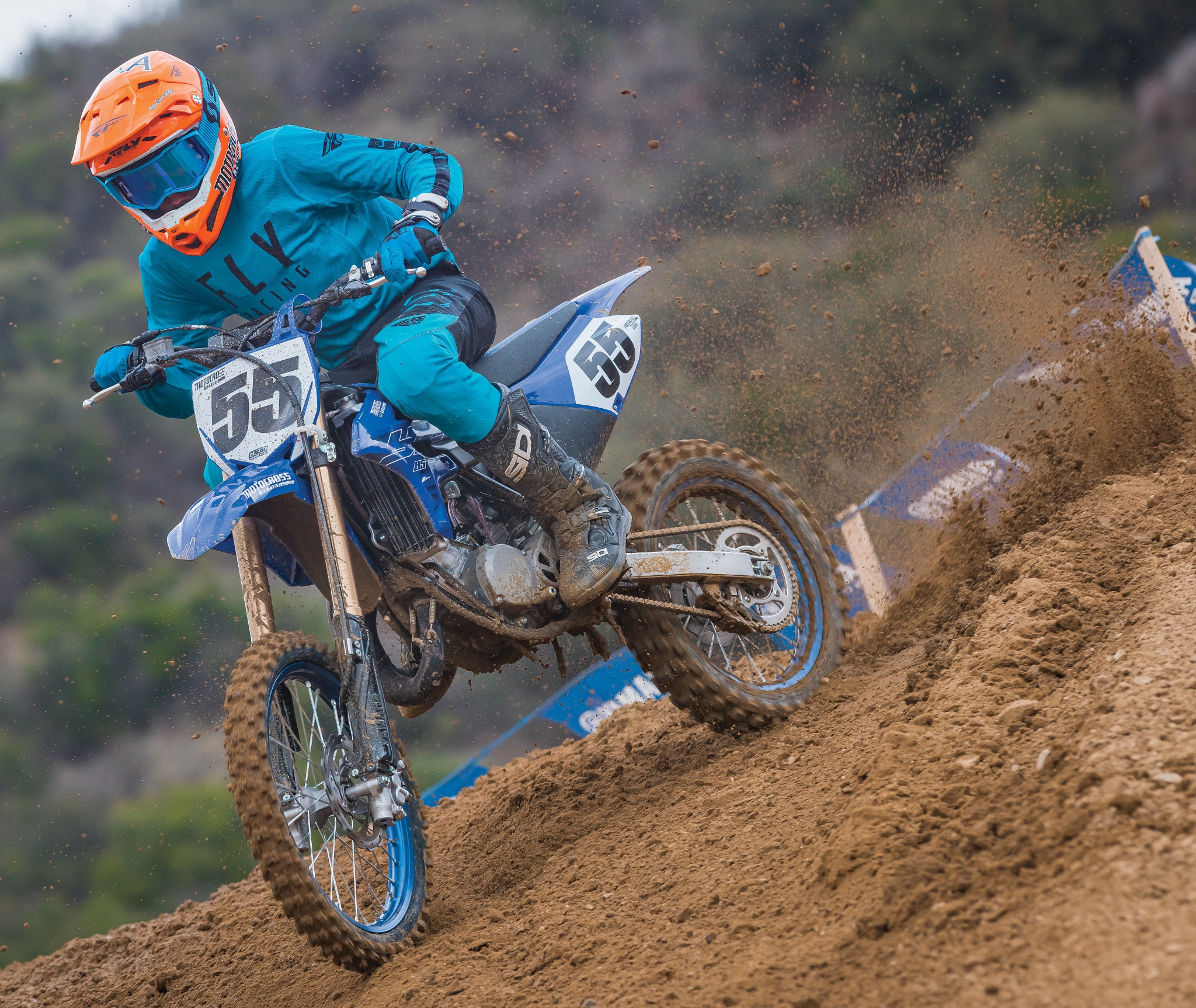
Q: WHAT DID YAMAHA CHANGE FOR 2022?
A: The 2022 Yamaha YZ85 received many updates that are similar to what they did on the YZ125s and YZ250s for the new model season. Here’s a list.
(1) Bodywork. The radiator shrouds, fuel tank, side panels, front fender and rear fender have all been modernized.
(2) Seat. The seat is now flatter, taller and skinnier than before. It also went from using two 6mm bolts to just a centerline bolt for installation.
(3) Subframe. The YZ85 switched from steel to an aluminum subframe to drop over 1/2 a pound and help make room for a straighter intake tract.
(4) Brakes. The rear brake master cylinder was updated to include a cast-in fluid reservoir. Now it requires less pedal stroke to slow the rear wheel.
(5) Frame. The frame received stronger engine mounts, and the rear brake master cylinder bracket was made stronger as well.
(6) Intake. Like the 125 and 250, the new subframe, side number panels and seat work together to create large intake vents at the rear of the seat. This creates a smoother and straighter path for air entering the engine, creating more power. The YZ85 also has a new air filter.
(7) Swingarm. It’s now a refined, one-piece, cast design instead of the previous three-piece design.
(8) Axle. The rear axle used to be hollow. Now it’s solid to increase strength and rear-wheel traction. The diameter is the same, but the wrench head was upped from a 17mm to a 19mm.
Q: HOW ARE THE YZ85 ERGONOMICS?
A: The bodywork on the 2022 Yamaha YZ85 and YZ85 Large Wheel is flatter, smoother, narrower and symmetrical. It also looks better. Previously, there wasn’t a shroud on the right-hand side of the YZ85. The riders’ legs simply squeezed the fuel tank. This also made it more difficult to install the graphics, because it meant that you needed perforated graphics to mount directly on the fuel tank. How come? Because, over time, the fuel sitting in the plastic tank would cause the graphics to bubble if the graphics didn’t have small slits or holes.
Now, the YZ85 matches the big-bike two-strokes with a new fuel tank and stylish looking shrouds. The new shrouds are also flatter. They are slightly wider at the seat and end up being 13.5mm skinnier at the radiator. The radiator louvers have also been updated to flow more air into the radiator fins.
As for the seat, it is now 3mm lower at the front, 12mm taller in the middle and 20-percent narrower. Our testers appreciated the modern styling of the YZ85. It is certainly better for taller riders, and it helped riders of all sizes get forward on the bike to weight the front wheel in turns. Before, the Yamaha two-strokes had banana-style seats—not anymore.
Q: HOW DOES THE YZ85 HANDLE?
A: All of Yamaha’s chassis updates for 2022 went towards making this bike stronger and more stable for top-level mini riders. Previously, smaller riders on the YZ85 suffered from head shake. The solid rear axle, thicker engine mounts, one-piece swingarm and aluminum subframe all work towards making the bike more stable for a faster, heavier minibike rider while lessening head-shake for smaller kids.
The updates translated into the Yamaha YZ85 being a well-suspended and stable mini-bike. The KYB spring forks and shock held up well for our youth test riders, and we were glad to have both compression and rebound adjusters on the forks for fine-tuning the suspension. Compared to the 2022 Kawasaki KX112 Supermini that we tested recently, the Yamaha YZ85 held up better and was less likely to blow through the stroke and bottom out in the braking bumps. Like the Kayaba suspension on the Yamaha big bikes, the YZ85 comes stock with a great starting point on spring rates and valving.
Q: HOW DOES IT RUN?
A: The 2002 to 2018 Yamaha YZ85 engine was not friendly. It was sluggish off the bottom end and then had an ultra-strong hit of power around the 8500-rpm mark. For 2019, Yamaha added its famous YPVS power valve system to the YZ85. This is a dual-valve mechanical system, and it begins to open and operate at 8500 rpm and is open fully at 9000 rpm. When the YPVS is open, the compression increases from 8.1:1 to 8.2:1. When the YPVS is closed, the compression ratio is significantly higher than the 2018 model’s at 9.6:1 compared to 8.1:1. This addition, plus a new crankcase shape, new combustion chamber shape, new reed block and new pipe, significantly broadened out the power in 2019, making the YZ85 easier to ride for Novices and easier to go fast on for Intermediates.
The 2022 Yamaha YZ85 runs a lot like the 2019 YZ85 because there haven’t been any engine upgrades since then. The only difference now is that the new intake tract increases efficiency for air entering the engine. This helped on throttle response, but it wasn’t a night and day difference in power for our youth testers.
Q: HOW DOES THE YZ85 COMPARE TO KTM AND KAWASAKI?
A: Compared to the KTM, the YZ85 is at a much more affordable price point. The YZ85 is priced $1600 below the $6399 2022 KTM 85SX. Compared to the $4699 KX85, it costs $100 more. With the prices in mind, the Yamaha has a few pros and cons compared to the green and orange 85 two-strokes. Here are some of the differences.
(1) Rear brake. On the KTM you can adjust the rear brake pedal position and amount of free play it has so that the rider doesn’t accidentally drag the rear brake. On the Yamaha and Kawasaki models, you can only adjust the position but not the free play.
(2) Forks. The KTM has WP XACT air forks with compression and rebound adjusters. Yamaha has KYB SSS spring forks with compression and rebound adjusters and Kawasaki only has a compression adjuster.
(3) Shock. The KX85 and YZ85 shocks have low-speed compression and rebound clickers, but they are missing the hi-speed compression adjuster that KTM has.
(4) Seat height. The KX85 has a 32.7-inch seat height. The KTM is 34 inches tall, and the new YZ85 is in the middle of the two at 33 inches. In general, the KX85 and YZ85 have always been better for smaller riders, while the KTM 85SX has been geared toward taller riders. Now, with the new seat and subframe, the YZ85 is taller, but not as tall as the KTM.
(5) Carburetor. The Kawasaki and Yamaha 85s have 28mm Keihin carburetors, while the KTM 85SX comes with a 38mm Mikuni TMX.
(6) Handlebars. The KX85 comes stock with 7/8-inch handlebars that bend far too easily. Both Yamaha and KTM 85s have 1-1/8-inch handlebars, which are stronger and better for the minibike racers of today.
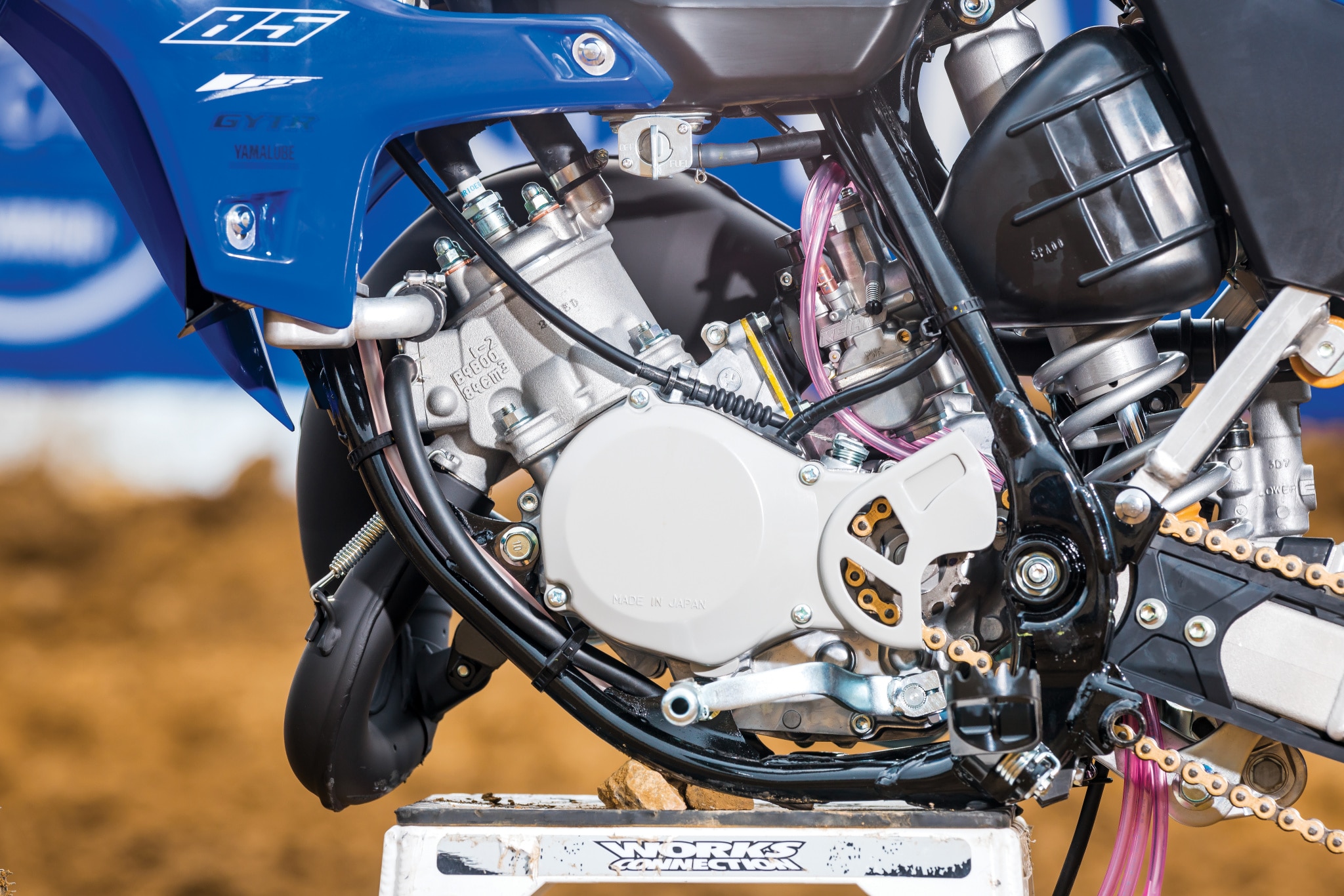
Q: WHAT DO WE HATE?
A: The hate list.
(1) Grips. Our hate list is minimal. The stock Yamaha grips are durable but not comfortable for our minibike testers.
(2) Gearing. Our testers complained that they had to shift more on the YZ85 than they do on its competition.
(3) Fork lugs. The fork lugs come down past the front axle, which causes them to drag in ruts.
(4) Engine. Although this version of the YZ85 is much better than the 2018 and prior models, it’s still not as fast as the KTM, Husky or GasGas bikes.
Q: WHAT DO WE LIKE?
A: The like list.
(1) Updates. It is refreshing to see Yamaha invest money in its minibike lineup. First, they came out with the YZ65. Then they updated the suspension and engine of the YZ85 in 2019, and now they’ve taken strides forward with their YZ85 for 2022 by making chassis updates.
(2) Large Wheel. We appreciate that Yamaha has added another minibike to its lineup with the YZ85LW. Also, if you buy little Johnny the standard YZ85 and later decide to turn it into a Supermini or big-wheel 85, you can purchase the longer swingarm ($771.99), swingarm pivot bearing kit ($79.99), longer rear brake line ($58.99) and longer chain ($67.99) through Yamaha’s GYTR catalog.
(3) Price. We love when manufacturers invest time and money into their new bikes. We love it even more when they keep the price reasonable for consumers. At $4799 for the YZ85 and $4999 for the YZ85LW, minibike riders can get in the game.
(4) Plastics. The YZ85 looks like a mini YZ125. It’s modern, symmetrical, sleek and stylish.
(5) Tires. We appreciate that Yamaha spec’d Dunlop MX3S tires.
Q: WHAT DO WE REALLY THINK?
A: The lockdowns of 2020 revitalized the world of outdoor sports and motivated families to go outside and enjoy time together participating in outdoor activities. For many families, it meant either going back to the track or trails where they hadn’t been in a while. For other families, it meant buying dirt bikes for the first time. Our sport has grown, and sales for mini-bikes have gone up, just like they have for big bikes.
Yamaha made big updates in 2019, but the YZ85 kept the same styling that it had for decades, which lessened the excitement for all of Yamaha’s R&D efforts. Now, the YZ85 looks like a modern racer, and with the stiffer frame, engine mounts, swingarm and subframe, it’s ready to withstand the needs of faster and stronger mini-cycle riders. Overall, this is an improved Yamaha YZ85 that will motivate the next generation of riders to keep learning, growing and racing on blue.
MXA’S 2022 YAMAHA YZ85/YZ85 LARGE WHEEL SETUP SPECS
This is how we set up our 2022 Yamaha YZ85 for racing. We offer it as a guide to help you find your own sweet spot.
KAYABA SSS FORK SETTINGS
Reminder, the rebound adjuster is on top of the forks, and the compression is on the bottom (opposite from traditional forks). For hardcore racing, we ran this setup on the 2022 Yamaha YZ85 (stock clickers are in parentheses):
Spring rate: 2.8 N/mm
Oil height: 105cc
Compression: 12 clicks out
Rebound: 7 clicks out
Fork-leg height: 23mm up
Notes: The SSS forks can handle heavy riders and hard landings. Don’t be afraid to soften up the ride by going out on compression for lighter riders. Also, be sure to bleed the air screw on top of the forks while the bike is still on the stand (with no weight on the front wheel) at the beginning of every day of riding.
KAYABA SHOCK SETTINGS
For hardcore racing, we ran this setup on the 2022 Yamaha YZ85 (stock clickers are in parentheses):
Spring rate: 49 N/mm
Race sag: 80mm
Lo-compression: 9 clicks out
Rebound: 6 clicks out
Notes: Our testers appreciated the balance of the KYB suspension. Riders chose anywhere from 75mm to 85mm of sag, depending on their personal preference.
YAMAHA YZ85 JETTING FOR THE 28mm KEIHIN PWK
Here are MXA’s recommended jetting specs (when changed, stock specs are in parentheses):
Main: 145
Pilot jet: 45
Needle: NBKF
Clip: 4th from top
Air screw: 1-1/2 turns



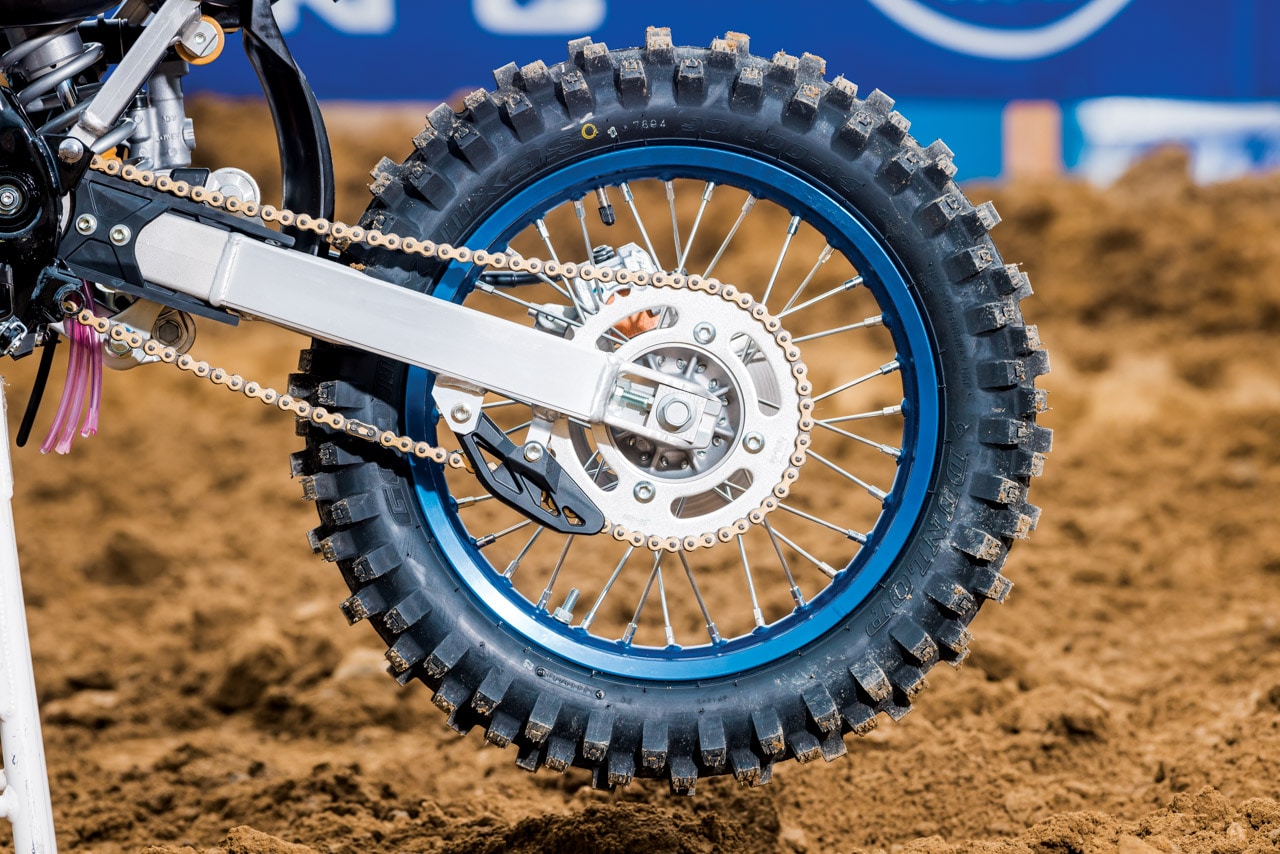

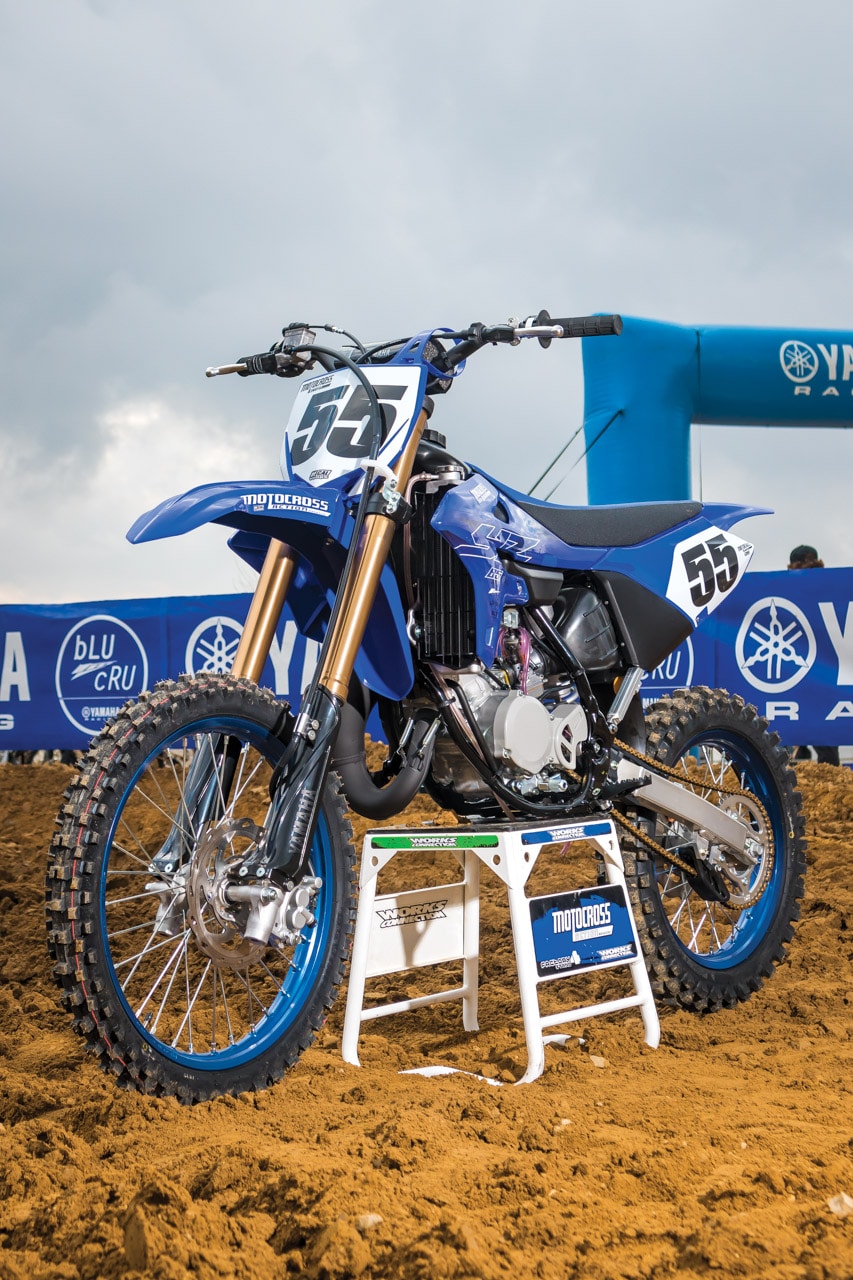
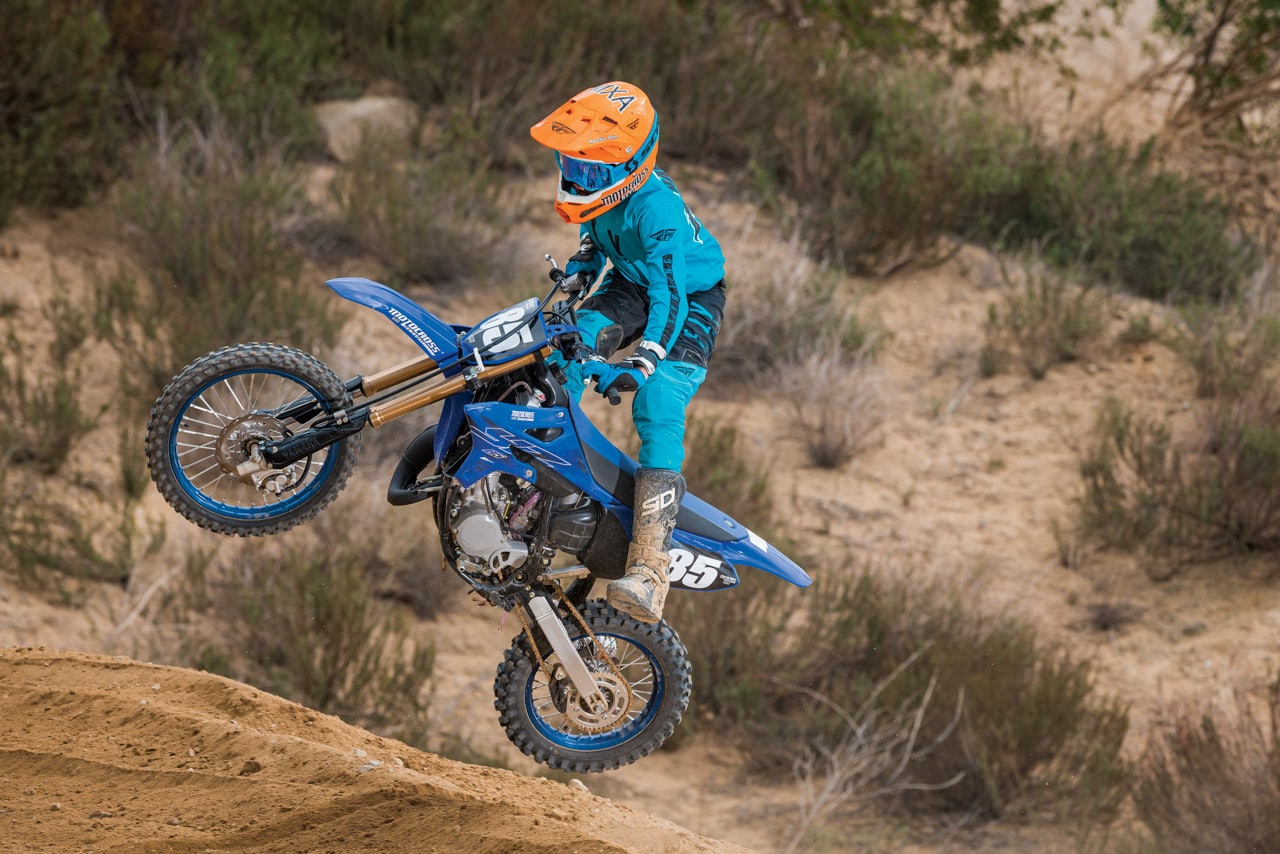


Comments are closed.